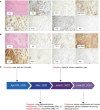Acute urinary retention due to corpus cavernosum penile metastasis from lung adenocarcinoma after targeted therapy: a case report and review of the literature
- PMID: 38496763
- PMCID: PMC10940509
- DOI: 10.3389/fonc.2024.1278245
Acute urinary retention due to corpus cavernosum penile metastasis from lung adenocarcinoma after targeted therapy: a case report and review of the literature
Abstract
Background: Metastasis in penile corpus cavernosum from adenocarcinoma of lung is a rare but fatal disease, which was reported in cases without series studies. It causes various clinical symptoms seriously affecting the quality of life.
Case presentation: A 72-year-old male smoker patient, who had a history of adenocarcinoma of lung after targeted therapy 36 months before, was admitted to Jiangxi Cancer Hospital because of presenting with aggressive dysuria and penis pain for one hour. A Foley catheter was inserted into the patient's bladder with difficulty. Immediately do a bladder puncture. Emergency pelvic computed tomography (CT): a soft tissue nodule of 1.1 cm×1.4 cm was found in the cavernous area of the middle part of the penis, and the proximal urethra was dilated with a wide diameter of about 1.5 cm. The diagnosis of metastatic lung adenocarcinoma from the primary was made by CT-guided biopsy.
Conclusion: The penis may be a site of metastasis from primary lung cancer, especially for old patient. Metastasis to the penis usually indicates that the primary lung cancer is at an advanced stage and the prognosis is very poor. More research is necessary to understand the underlying mechanism of adenocarcinoma of lung metastasis.
Keywords: adenocarcinoma of lung; case report; metastasis; penile; targeted therapy.
Copyright © 2024 Yan, Fu, Liu, Liu, Qi and Chen.
Conflict of interest statement
The authors declare that the research was conducted in the absence of any commercial or financial relationships that could be construed as a potential conflict of interest.
Figures




Similar articles
-
Metastasis in penile corpus cavernosum from esophageal squamous carcinoma after curative resection: a case report.BMC Cancer. 2019 Feb 20;19(1):162. doi: 10.1186/s12885-019-5356-3. BMC Cancer. 2019. PMID: 30786867 Free PMC article.
-
Penile metastases of rectal adenocarcinoma.J Visc Surg. 2014 Feb;151(1):53-5. doi: 10.1016/j.jviscsurg.2013.08.009. Epub 2013 Sep 18. J Visc Surg. 2014. PMID: 24055405
-
Metastasis to the penis in a patient with adenocarcinoma of lung, case report and literature review.Med Oncol. 2009;26(2):228-32. doi: 10.1007/s12032-008-9113-8. Epub 2008 Oct 31. Med Oncol. 2009. PMID: 18975150 Review.
-
Metachronous isolated penile metastasis from sigmoid colon adenocarcinoma: A case report.World J Clin Cases. 2022 Nov 6;10(31):11658-11664. doi: 10.12998/wjcc.v10.i31.11658. World J Clin Cases. 2022. PMID: 36387791 Free PMC article.
-
Fibrosarcoma of the corpus cavernosum: case report and literature review.BMC Surg. 2021 Jan 6;21(1):20. doi: 10.1186/s12893-020-01006-0. BMC Surg. 2021. PMID: 33407309 Free PMC article. Review.
Cited by
-
A patient with penile metastasis secondary to small cell lung cancer successfully treated with PD-1 inhibitors and chemotherapy: a case report and literature review.Front Oncol. 2025 Feb 25;15:1484365. doi: 10.3389/fonc.2025.1484365. eCollection 2025. Front Oncol. 2025. PMID: 40071100 Free PMC article.
References
Publication types
LinkOut - more resources
Full Text Sources

